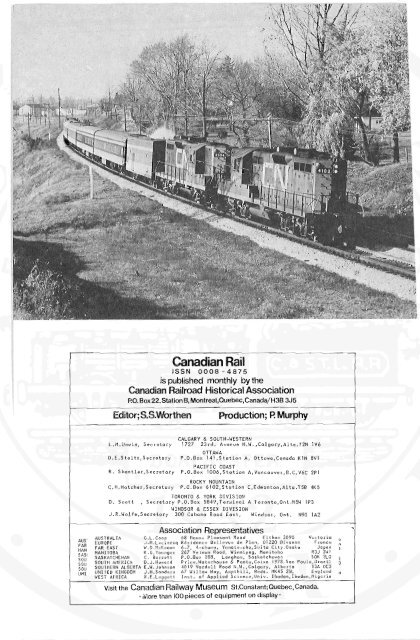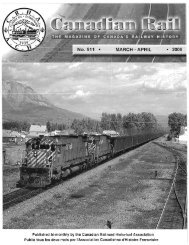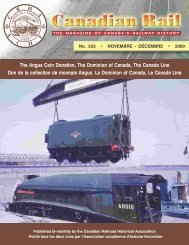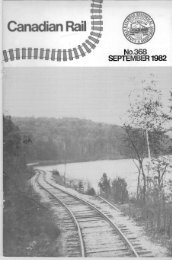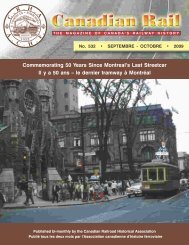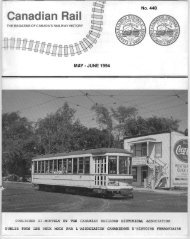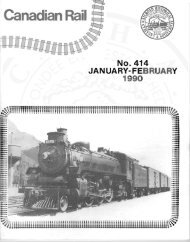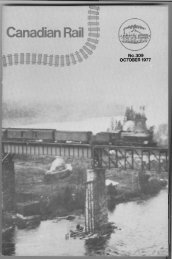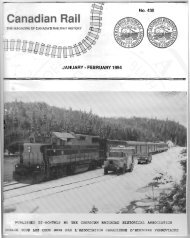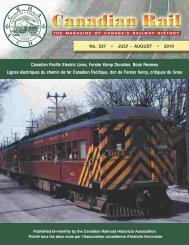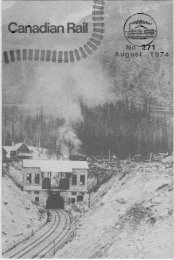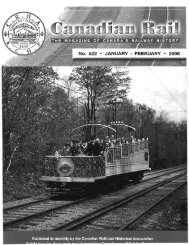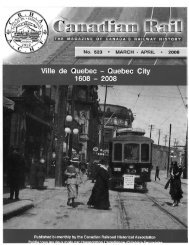Canadian Rail_no292_1976
Canadian Rail_no292_1976
Canadian Rail_no292_1976
You also want an ePaper? Increase the reach of your titles
YUMPU automatically turns print PDFs into web optimized ePapers that Google loves.
CANADIAN 145 R A I L<br />
True narrow-gauge railways ( 3 feet 6 inches, or less) could, of<br />
course, be built for reasons of economy, but if they were built, it<br />
was with the clear understanding that they were narrow-gauge and could<br />
not expect their standard-gauge neighbours to make any special concessions<br />
on account of the difference. The Stephenson gauge was firmly<br />
established. If you wanted your company to participate in the exchange<br />
of interline traffic, that was the guage you adopted.<br />
Curiously enough, Canada's first two public railways, the Champlain<br />
and St. Lawrence and the Lanoraie and Village d'Industrie <strong>Rail</strong><br />
Roads were both built to the Stephenson gauge, the first in 1836 and<br />
the second in 1850. Contrariwise, the St. Lawrence and Atlantic/ Atlantic<br />
and St. Lawrence, Canada's first long-distance railway, was<br />
planned ond constructed to a 5-foot 6-inch gauge. Indeed, when the<br />
Grand Trunk <strong>Rail</strong>way Company of Canada obtained its charter in 1853 ,<br />
it was obliged by law, if you please, to adopt this "Provincial Gauge".<br />
So was the Great Western <strong>Rail</strong>way in southern Ontario. How did<br />
this unwise legislation get on the statute books?<br />
By 1867, Confederation had been accomplished, God was in Heaven<br />
and Sir John A. Macdonald was ensconced in Ottawa as Canada's first<br />
prime minister. The Grand Trunk - the MAIN LINE - boasted a magnificent<br />
broad-gauge, trunk-line railway from Portland, Maine, U.S.A.,<br />
to Sarnia, Ontario, on the St. Clair River near Lake Huron. This<br />
impressiue 5-foot 6-inch gauge empire was not destined to endure unchanged,<br />
for practical necessities led to the eventual decision to<br />
narrow the gauge to the Stephenson width by 1875.<br />
You could say that, prior to 1845, the gauge of a <strong>Canadian</strong> railway<br />
was largely determined by the equipment that it purchased from<br />
the United States or England. This apparently "cart-before-horse" situation<br />
becomes logical with the realization that English locomotive<br />
builders generally chose the Stephenson gauge, while United States<br />
builders tended to favour that gauge. There were other gauges, granted,<br />
but George Stephenson was after all the "Father of the <strong>Rail</strong>way"<br />
and Isambard Kingdon Brunel and his 7-foot 0 3/4-inch-gauged railway<br />
could hardly be taken seriously.<br />
On the <strong>Canadian</strong> scene, the British Government who were in fact<br />
still responsible for the defense of the <strong>Canadian</strong> colonies had not<br />
completely recovered emotionally from the War of 1812. They lived in<br />
trembling, if not in fear, that there would be a . future invasion of<br />
British North America, probably from the south. To frustrate the<br />
possibility of <strong>Canadian</strong> railways being used to the advantage of the<br />
enemy, they decided a gauge of 5 feet 6 inches would be advantageous.<br />
There were other reasons for the adoption of this gauge. Mr.<br />
Miles Pennington, the first Freight Traffic Manager of the Grand Trunk<br />
<strong>Rail</strong>way in 1853, made a visit to Portland, Maine in that year<br />
and reported that the broad-gauge had been chosen in order that Portland<br />
should be the terminus of <strong>Canadian</strong> railroads and thus the trade<br />
would be prevented from going past Portland to Boston. Mr. Pennington's<br />
conclusion apparently received wide acceptance and for many<br />
years was considered as the "real" reason for the adoption of the<br />
Broad-gauge in Canada.<br />
Now let us turn to the real sequence of events. In 1846, before<br />
construction began on the first portion of Canada's first main-line<br />
railway, the Government of Canada appointed a committee to inquire<br />
into the subject of the gauge of this, and succeeding, railways. By<br />
1851, the Government got around to receiving the report of the com-


